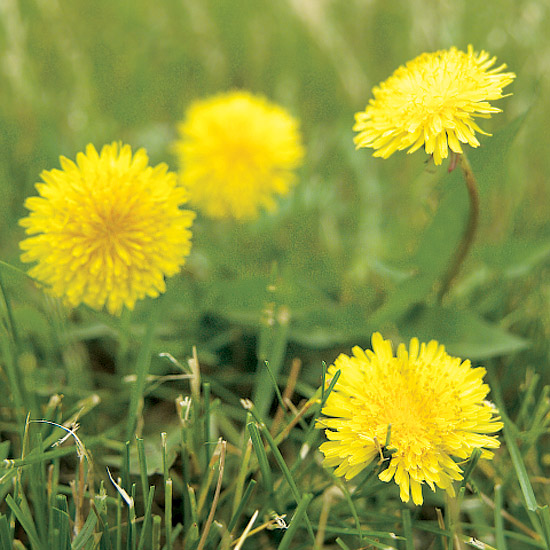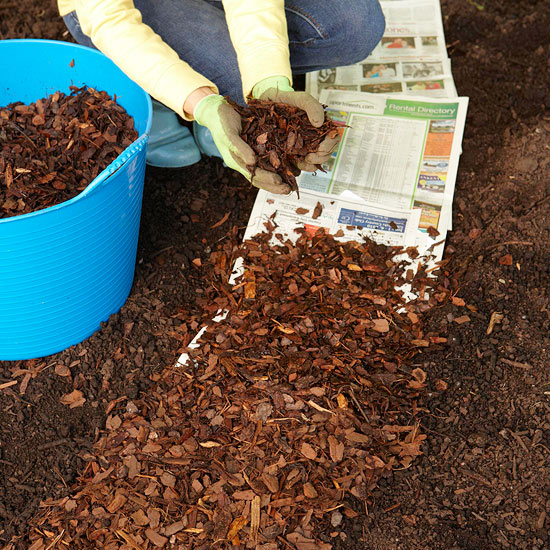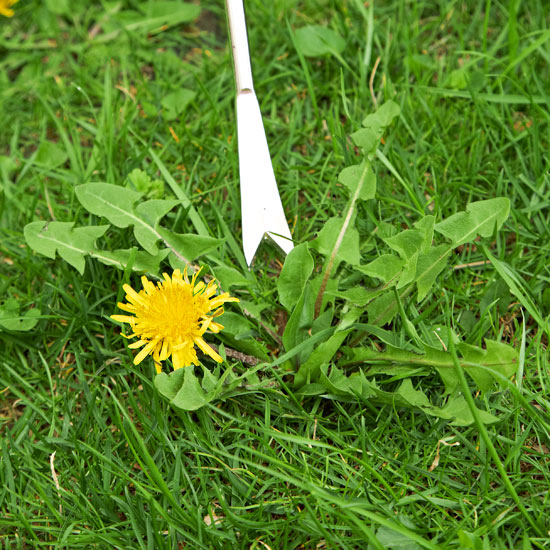






It's hard to have compassion for weed plants, but they're just plants growing in places where they're not wanted. Consider trying this philosophy: If you like it, it's a flower; if you don't, it's a weed.
That said, it's perfectly reasonable to wage war on weeds in vegetable and perennial gardens. Eliminating them as soon as they show their unwanted faces pays off in the long run. And the activity of weeding can be rather therapeutic.
To grow organic produce, never use chemicals to kill weeds in the vegetable garden.
Get tips for growing organic vegetables.
In perennial beds, a preemergent herbicide can prevent weed seeds from sprouting. This water-activated product stops all seed germination, so never use it in places where you're sowing flower seeds.
Here are top tips on how to eliminate weed plants from your garden.
continue reading belowThere are two types of weeds.
The first type produces enormous quantities of seeds. These weeds are easy to pull or hoe, but new ones keep appearing.
The second type is harder to kill, often because these weeds have persistent underground roots or other parts that can sprout into new plants.
And then you have the mighty dandelion, which combines the best (or worst) of both types. When weeding, extract the entire root because even a small part can regenerate the plant. A 2-inch-thick layer of mulch helps prevent seeds from germinating and makes those that emerge easier to remove.
Learn how to identify different types of weeds.
The best time to tackle weeding chores is right after irrigating or a rainfall. It's easiest to pull or dig weeds out in their entirety when the ground is soft.
To avoid feeling overwhelmed, tackle a small space every day, rotating throughout your garden. It's certainly easier to face weeding in small increments than it is to face weeding your entire yard.
Get more tips to make your gardening tasks easier.
After weeds are pulled or dug out, remove them entirely from the garden. Some weeds can grow back or go to seed if left where they are. Keep weeds out of the compost pile unless you are able to maintain heat high enough to kill any weed seeds. Most home compost piles don't get that hot.
Get tips for making your own compost!
For a simple, chemical-free way to kill vegetation, try boiling water. A teakettle is an effective way to deliver a stream of heated water between the cracks of concrete or bricks. Just realize that everything the water touches will die from the heat, not just weeds.
Plant cover crops to reduce weeds. A cover crop, sometimes called green manure, is a fast-growing beneficial plant that outcompetes weeds for light and nutrients. Cover crops include wheat, barley, oats, rye, sorghum, and sudangrass. Some even release weed-suppressing natural chemicals while they're growing or decomposing. They can be planted any time during the growing season, then plowed or turned under when it's time to plant vegetables or flowers.

Organic mulch is a great garden product. Not only does it help conserve moisture and add organic matter to the soil, it blocks light, which helps suppress weed germination.
Add a 2- to 3-inch layer of chopped leaves, compost, untreated grass clippings, pine straw, cocoa hulls, or shredded hardwood or cypress bark to beds. Avoid putting mulch directly against the stems, twigs, and trunks of plants because fungi and bacteria can enter the plant from moist mulch.
Barriers can also be used with mulch. Newspapers make a good barrier, but must be topped with mulch so they don't blow away in a stiff wind.
You can use black or clear plastic to solarize your soil. Place the plastic in a sunny area where you want to kill vegetation and seeds below, and leave it in place for 4-6 weeks. Avoid using plastic as a permanent barrier, however, because soil needs air to grow plants.
Learn more about mulch!

Your hands are often the best all-purpose weeding tools, but when you need a little more power, try one of these.
Cutting and scraping tools work best for sliding behind and beneath weeds to chop stems from roots. Use angled triangular blades to weed cracks and crevices.
Fishtail or taproot weeders have a V-shape tip on the end of a long tool that you slip on either side of a weed stem (such as a dandelion) to pry the root from the soil.
Digging knives (also called hori-horis) are versatile tools that can dig holes, divide perennials, dig taproot weeds, and scrape weed seedlings from the soil.
Oscillating hoes have sharp-edge stirrup-shape blades and long handles. Eradicate weeds by moving the blade back and forth in the soil. These work well in a vegetable garden when you want to sever young weeds between rows.
Get our tool-sharpening tips.
A plethora of weeds invade our gardens. Here are some of the most common.
Bermudagrass (Cynodon dactylon) is a perennial grass with a vigorous creeping habit. The roots may grow several feet deep, making the plants drought- and heat-tolerant and difficult to kill. Bermudagrass spreads by seeds as well as above- and belowground stems. To kill, smother the leaves with a heavy layer of landscape fabric or black plastic for several months. If a Bermudagrass lawn surrounds your garden, prevent the grass from creeping into edibles by burying vinyl edging at least 6 inches deep or by gardening in raised beds.
Common chickweed (Stellaria media) prefers damp, shady areas with rich soil. Chickweed is a winter annual that grows from seeds sprouting in the fall. The 1/2- to 2-inch heart-shape leaves are attached to the stem by a slightly hairy stalk. Creeping stems joint into roots wherever they touch the soil (similar to creeping Charlie). Hand cultivation and a 2-inch-thick layer of mulch used together provide the best control.
Crabgrass (Digitaria spp.) is an annual weed that grows fast in hot, dry weather. The blades are 2-5 inches long and 1/3 inch wide. Seeds remain dormant over the winter and sprout in spring. If left to grow, they produce seeds then die with frost. To kill crabgrass, use mulch, water the surrounding plants only as necessary, and weed frequently. A preemergent weed-control product containing corn gluten is effective in spring but will prevent all annual seeds from germinating.
Lamb's quarters (Chenopodium album) grows 1-4 feet tall from a short-branched taproot and is common in gardens. Leaves are 1-3 inches long with toothed edges. Seeds remain dormant over the winter and sprout in spring. To kill, hand-pull or remove by hoeing. A 2-inch-thick layer of mulch prevents seeds from germinating. A preemergent weed-control product containing corn gluten is effective in spring but will prevent all annual seeds from germinating.
Nutsedge (Cyperus spp.) includes two troublesome species: yellow nutsedge and purple nutsedge. Both prefer poorly drained, rich soil. They thrive in frequently watered garden areas. Grasslike, yellow-green leaves grow on erect triangular stems. Seed heads are purple or yellow, appearing from July to October. Nutsedges reproduce by seeds, underground stems, and nutlike tubers. Dig up the plants and dispose of the soil to get rid of the tubers.
Purslane (Portulaca oleracea) is a common annual weed that thrives in hot, dry weather. Purslane leaves are 1/2 to 1-1/2 inches long, succulent, and wedge shape. Small yellow flowers open only in full sunlight from midsummer to frost. The seeds may remain viable in soil for many years and sprout in warm weather when they're brought to the soil's surface during tilling or cultivating. Thick, reddish stems grow vigorously, forming a mat that roots wherever the stems touch the soil. Because purslane grows low to the ground, an oscillating hoe is effective. Uprooted plants may reroot if left in place. A 2-inch-thick layer of mulch prevents seeds from germinating.
Quackgrass (Agropyron repens) is a perennial grassy weed often found in the northern United States. Its extensive fibrous root system consists of long, yellow-white roots that may grow 5 feet or more in a single growing season. The narrow, bluish-green leaves grow on stalks 1-3 feet tall. Wheatlike spikes produce seeds from May to September. Seeds may survive in the soil for up to four years, but most germinate in spring within two years. Underground creeping rhizomes also send up new shoots, increasing the infestation. If there are only a few clumps, dig them up. This weed may need a chemical control, such as an herbicide containing glyphosate.
Copyright © www.100flowers.win Botanic Garden All Rights Reserved